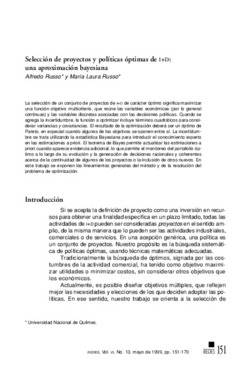Selección de proyectos y políticas óptimas de I + D : una aproximación bayesiana.
The selection of optimal R + D projects and policies : a Bayesian approach.
Fecha
1999-05Autor
Russo, Alfredo; Russo, María LauraResumen
La selección de un conjunto de proyectos de I + D de carácter óptimo significa maximizar una función objetivo multicriterio, que reúne las variables económicas (por lo general continuas) y las variables discretas asociadas con las decisiones políticas. Cuando se agrega la incertidumbre, la función a optimizar incluye términos cuadráticos para considerar variancias y covariancias. El resultado de la optimización deberá ser un óptimo de Pareto, en especial cuando algunos de los objetivos se oponen entre sí. La incertidumbre se trata utilizando la estadística Bayesiana para introducir el conocimiento experto en las estimaciones a priori. El teorema de Bayes permite actualizar las estimaciones a priori cuando aparece evidencia adicional, lo que permite el monitoreo del portafolio óptimo a lo largo de su evolución y la generación de decisiones racionales y coherentes acerca de la continuidad de algunos de los proyectos o la inclusión de otros nuevos. En este trabajo se exponen los lineamientos generales del método y de la resolución del problema de optimización. The selection of an optimal portfolio of R + D projects means maximizing a multicriteria objective function which considers the generally continuous economic variables as well as the discreet variables associated with political decisions. When uncertainty is added, the function of optimizing involves quadratic terms which appear as a result of variances and co-variances. The optimal result will be a Pareto optimum, especially when some of the objectives are opposed to each other.
Uncertainty is managed by using Bayesian statistics to consider expert knowledge in prior estimates. Bayes’ theorem allows us to obtain subsequent estimates as additional evidence appears, which in turn facilitates the monitoring of the optimum portfolio over the course of its evolution as well as the generation of rational and coherent decisions about whether to continue with some projects or to incorporate others. In this work, a general outline of the method is expounded in addition to the methodology for solving the problem of optimization.

